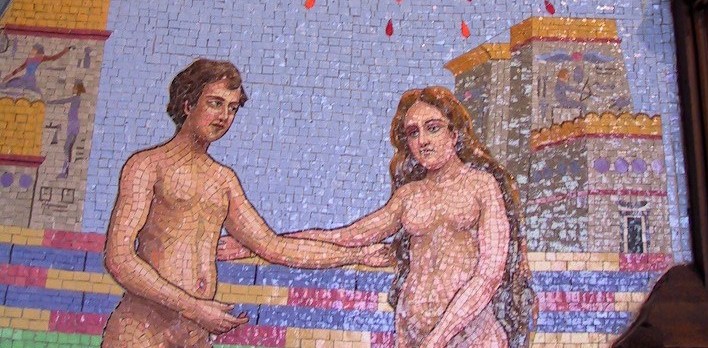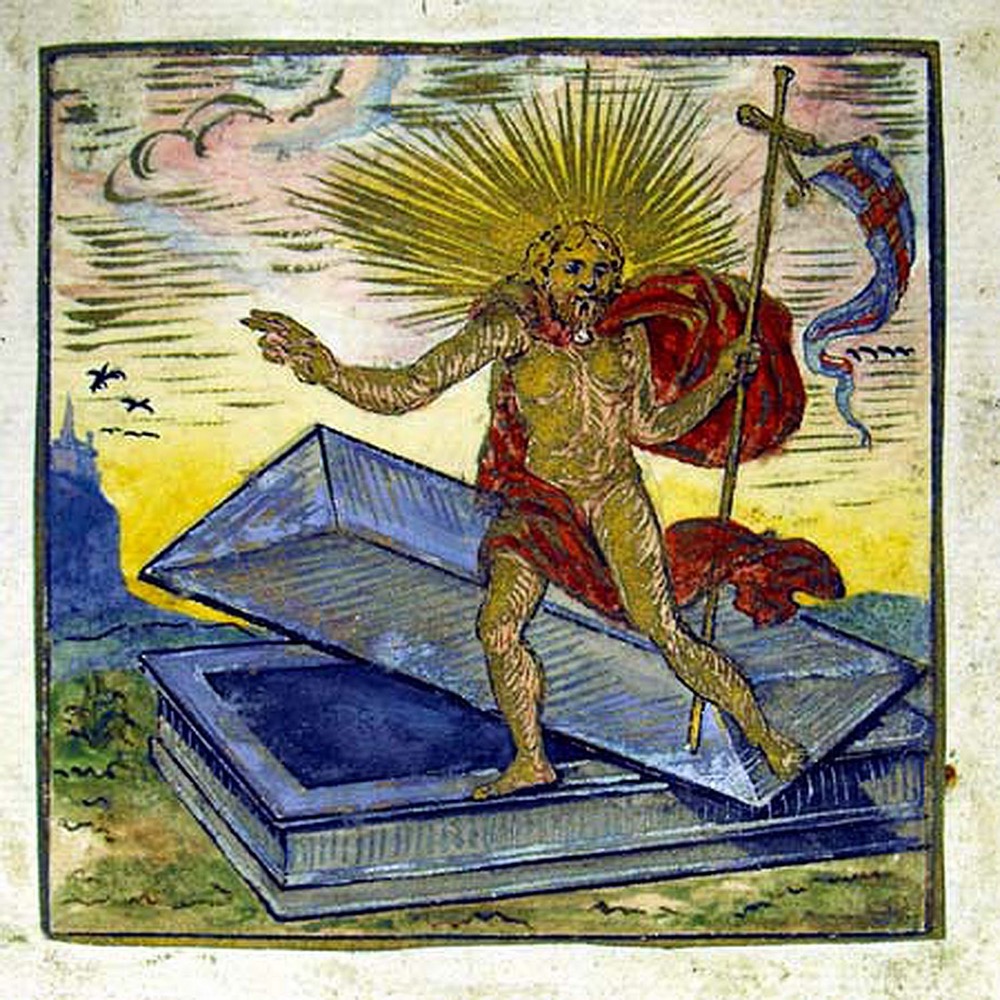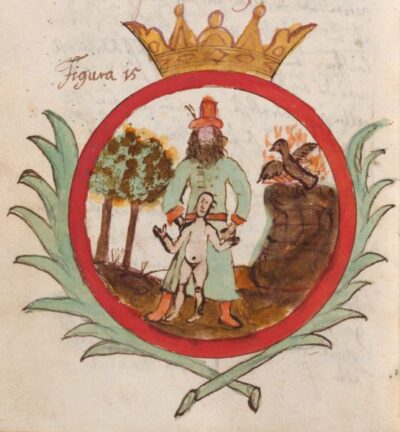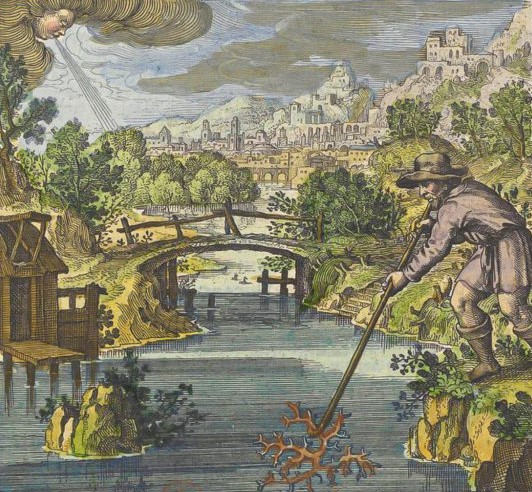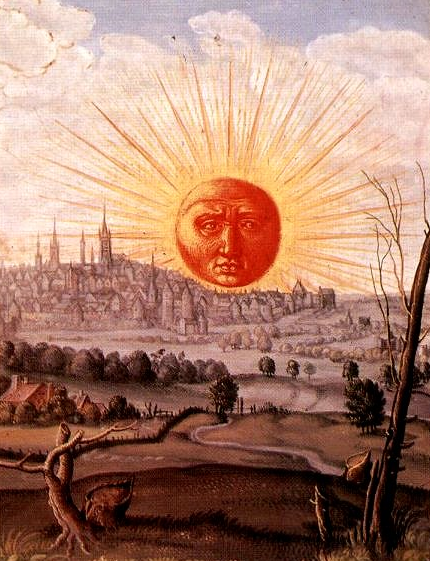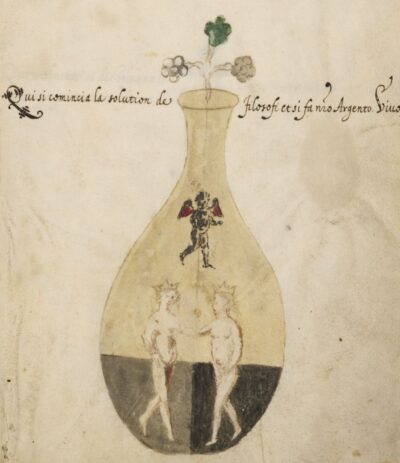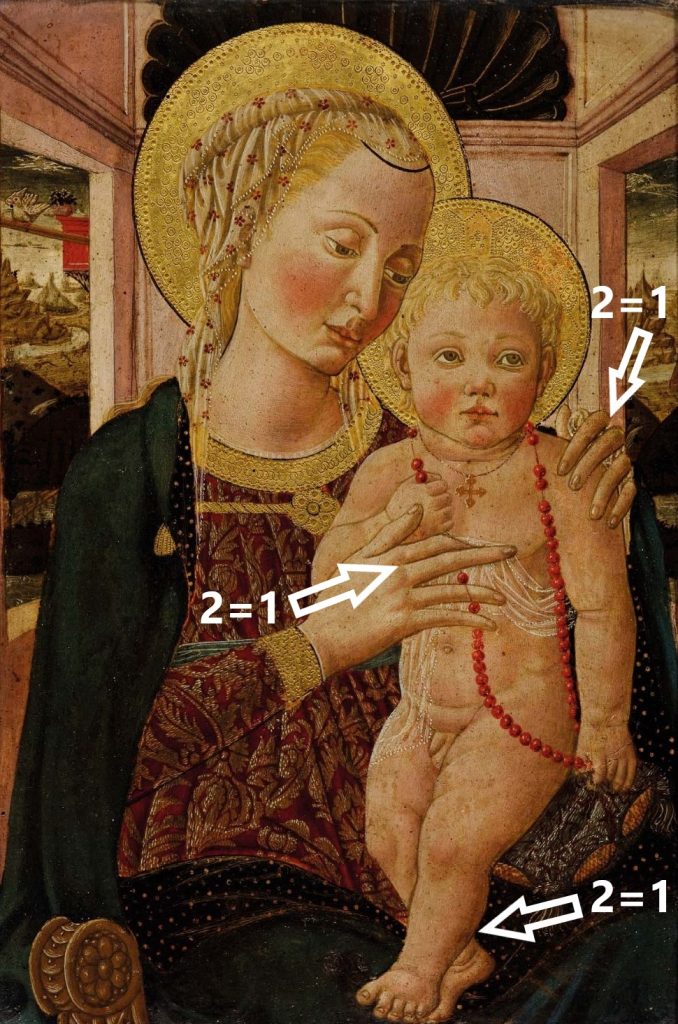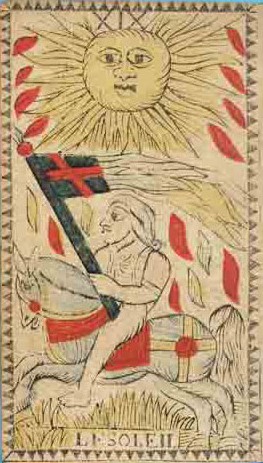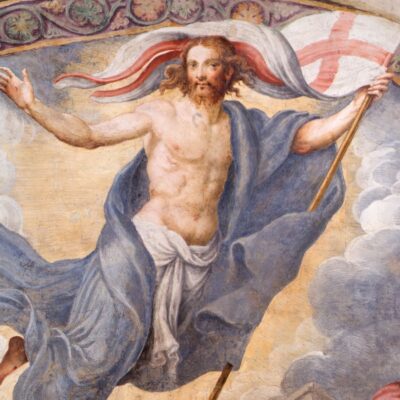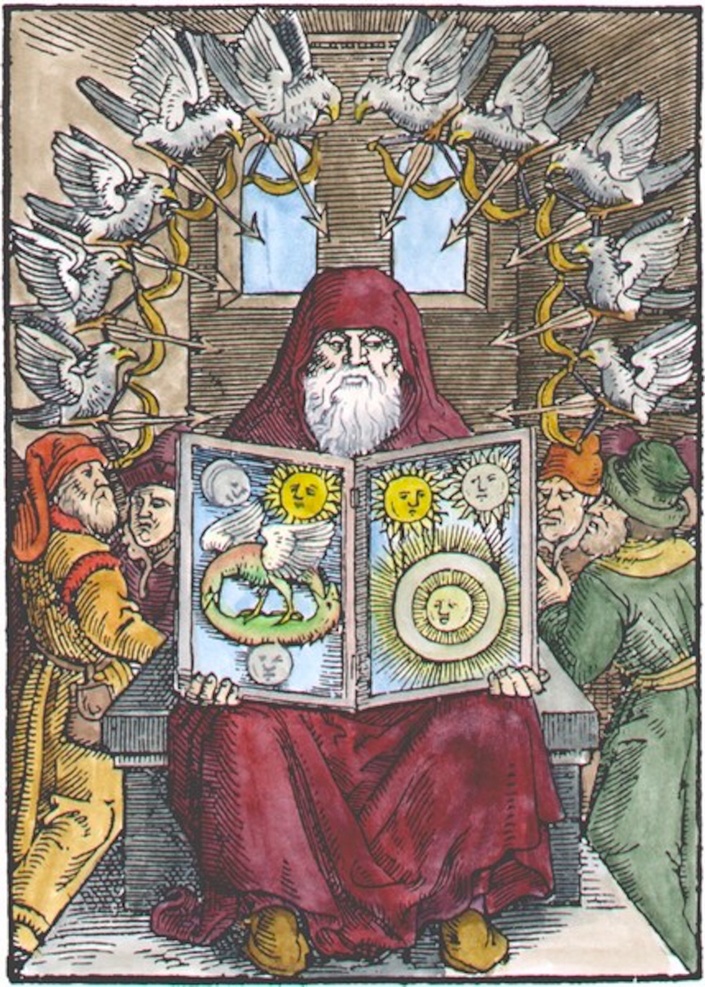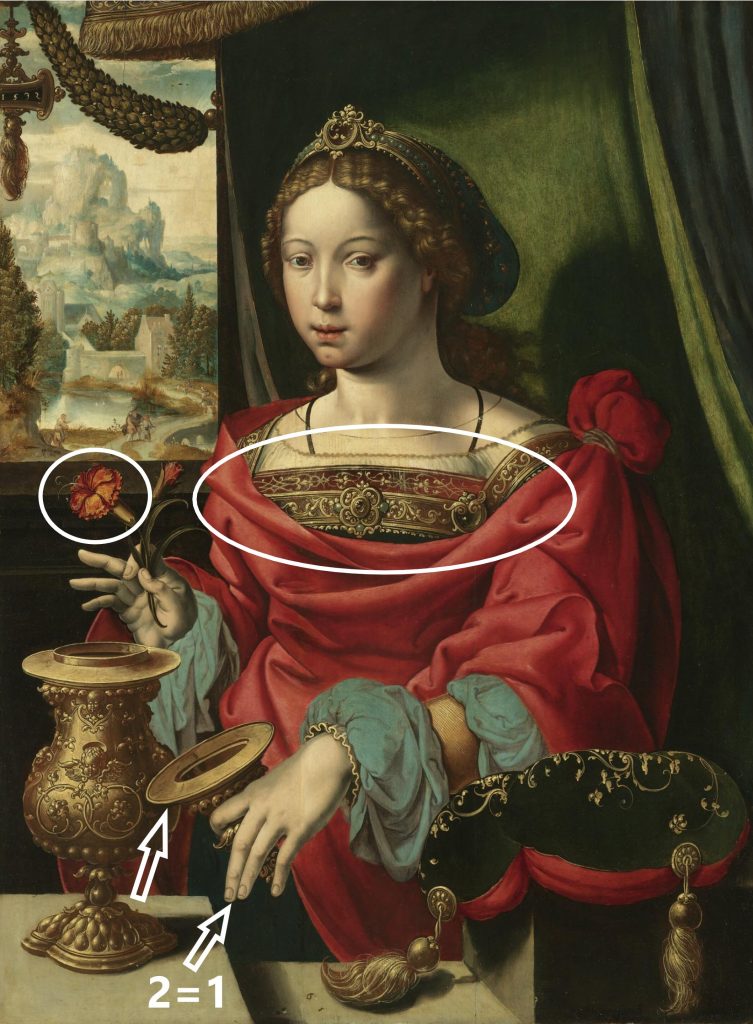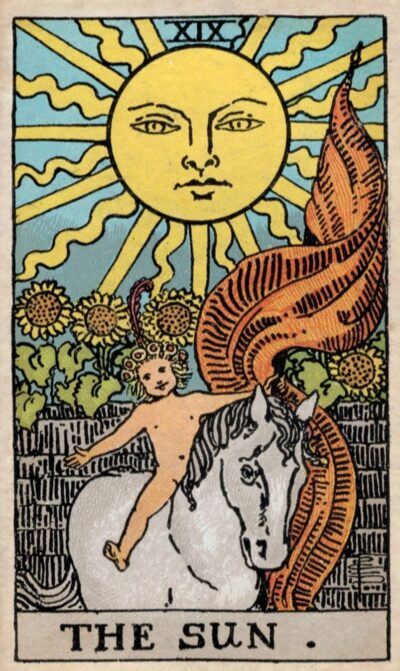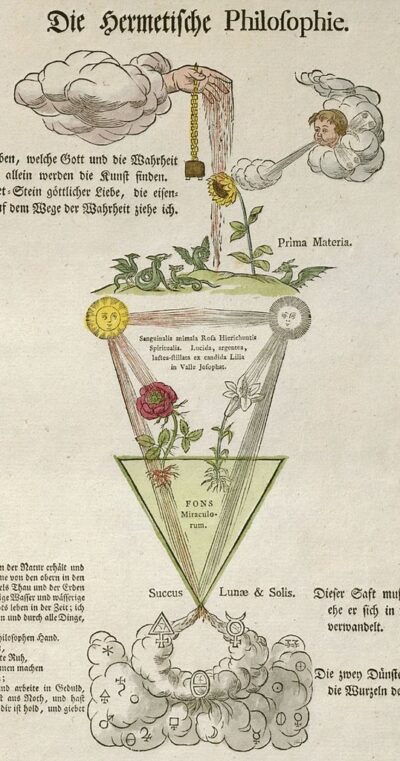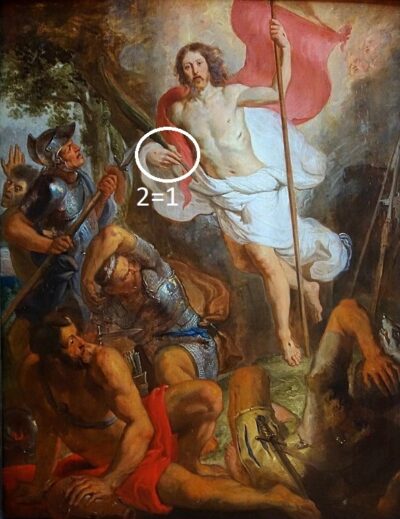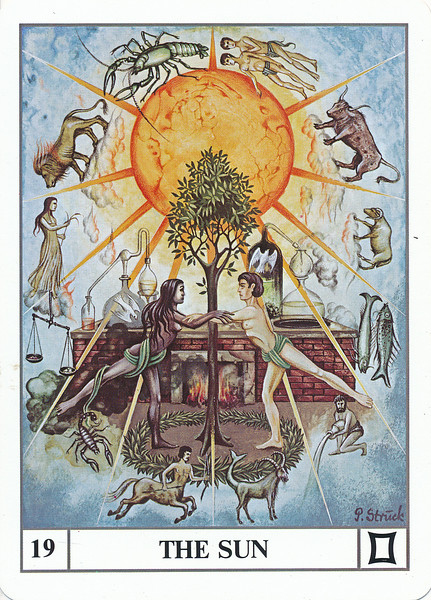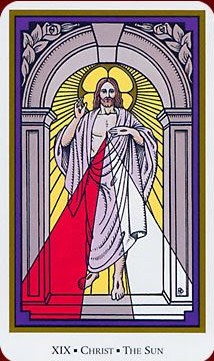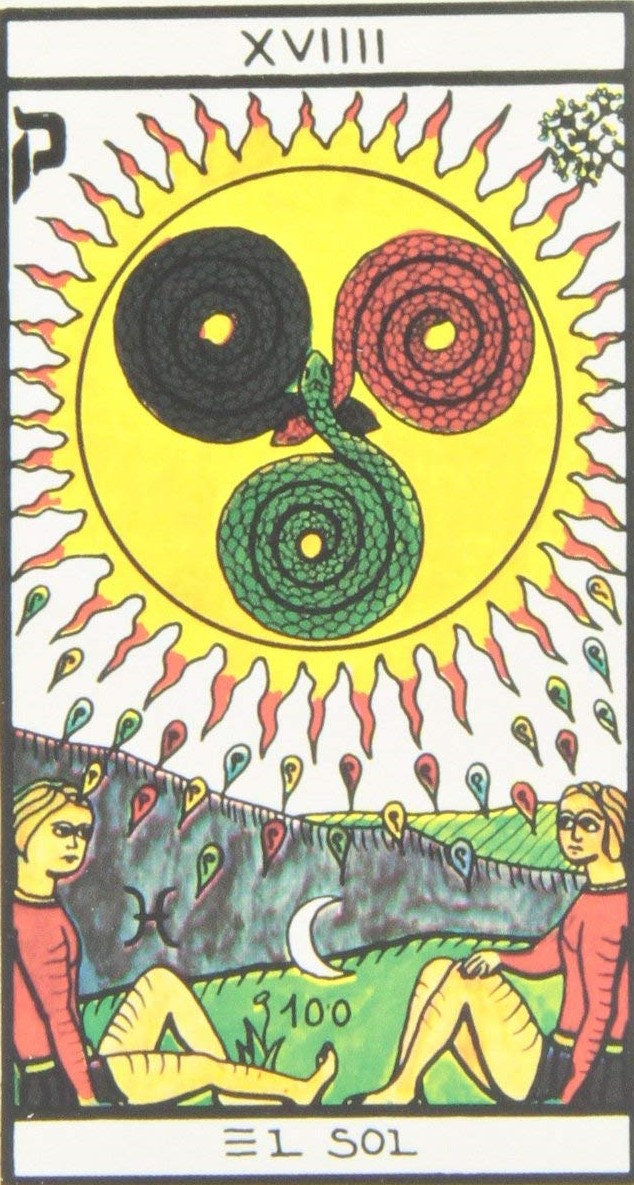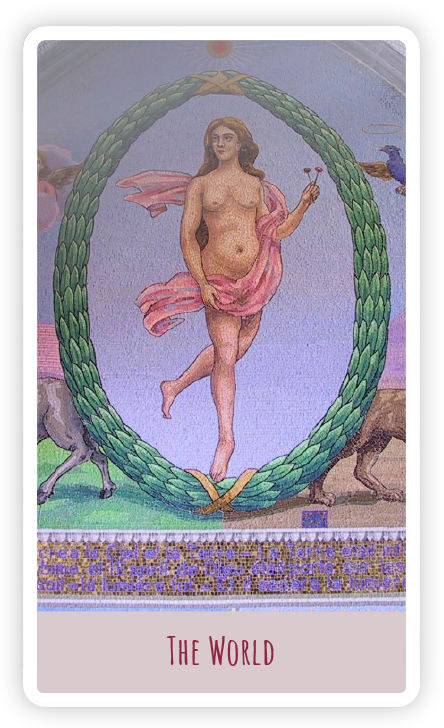19. The Sun
The always shining sun, which with its light and warmth makes life on earth possible, has been a symbol of the divine since ancient times. Tarot card number 19 represents spiritual completion, telling us how man can realize the sun / divine within himself. The very first tarot decks used symbolism from alchemy to communicate this.The Viconti-Sforza Tarot
All elements on the Visconti-Sforza card (below left) refer to a spiritual rebirth, as a result of a kundalini awakening. The angelic figure on a cloud in the sky represents the human being who has detached himself from the world and has discarded the ego. The wings represent deification of matter. Standing on one leg refers to the merging of the polar energies: the sacred marriage (2=1). The three mountains represent the three energy channels involved in a kundalini awakening.
Through an intensive purification and healing process, this person has returned to the state of wholeness of a young child; in alchemy called Filius Philosophorum (Philosopher’s Child), or Infans Solaris (Sun Child).
Rosarium Philosophorum (18th century). With his right hand Jesus makes the SIGN OF SACRED MARRIAGE: 2=1 (click here).
Both the red coral necklace and the red ribbon refer to the kundalini energy. Red is the color of (kundalini) fire and of the first chakra, the abode of this divine energy before awakening. The two flying ends of the ribbon represent the inner duality, which merges into divine unity.
A severed head is a universal metaphor for the discarding, or death, of the ego. The color red of the head in this case refers to the Magnum Opus (completed spiritual process) of the alchemist. Both the color red and gold are used for the Magnum Opus. In the illustration below on the left, from the alchemical work Splendor Solis, the severed head is golden.
The white, dismembered body refers to the purification process that the alchemist went through. The GOLDEN HEAD symbolizes that he has discarded his ego. The man with the SWORD (click here) represents the kundalini process itself. The colors BLACK, WHITE AND RED represent the three alchemical phases: NIGREDO, ALBEDO EN RUBEDO (click here). The THREE STRANDS of CURLING HAIR, flying in the air, represent the three energy channels involved in this process. (Splendor Solis, emblem 10, 1535).
Before the alchemist stands the FILIUS PHILOSOPHORUM, his reborn self. On the right a PHOENIX rising from its ashes, and on the left TWO TREES joined together and bearing FRUIT; a metaphor for a completed kundalini process. (Testamentum Der Fraternitet Rosae et Aurae Crucis, early 17th century)
The alchemist fishes RED CORAL (the kundalini) from the water (his subconscious). The ANGEL BLOWING AIR (upper left corner) must tell us that the coral represents something divine. (Atalanta Fugiens, 1617)
The last illustration from the alchemical manuscript Splendor Solis (1535). The RED SUN rising over the city represents the completion of the Great Work (Magnum Opus).
The Filius Philosophorum (the CHILD WITH WINGS) is the result of the union of KING AND QUEEN (the duality) in the alchemist (the flask). The THREE FLOWERS represent the three energy channels involved in this process.
The RED CORAL necklace, which runs from the PELVIS to the HEAD of the baby Jesus, is a (disguised) reference to a kundalini process. The same goes for the transparent SCARF that Maria is holding. Mary subtly makes with both hands the SIGN OF THE SACRED MARRIAGE: 2 = 1 (click here). The CROSSED LEGS (click here) of the Jesus child also refer to SACRED MARRIAGE. (Bernardo di Stefano Rosselli, circa 1500)
The Tarot of Marseille and family
The Tarot of Marseille uses different elements to tell the same thing. Francois Chosson’s card (below left) shows two identical boys holding each other. This symbolizes that they are connected. The two boys represent the duality that merges into divine oneness in the spiritual aspirant. Together they stand for the born again human. The wall around the boys tells us that this is an inner experience.
The red collar around their necks is the red coral necklace from the Visconti-Sforza card (above), which refers to a kundalini awakening. The vertical stripes on the boys’ torso refers to the spine. The boy on the left touches the boy on the right in this place with his hand. This is an indication to us that the working force is the kundalini energy, which is also symbolized by the flames coming from the sun. We also see these flames on the tarot card The Moon, on which they refer to the “descending tongues of fire of the Holy Spirit (the kundalini)”.
On the Italian Piedmontese card (far right), from more than a century later, both boys stand on one leg. This element also refers to the (divine) oneness they form together.
We also find similar elements on the three alchemical emblems below from the same time period, with (phases of) the Magnum Opus.
On the tarot cards above the sun’s energy is manifested as light and heat (straight and curved rays). The number of red and yellow rays on both cards is exactly eight. This is a reference to the Morning Star, which has been a symbol for the kundalini energy since ancient times (see also tarot card The Star). The sun is an apt symbol for the Morning Star since it is a star herself.
The KUNDALINI FIRE purifies the alchemist, and his inner duality fuses into oneness. (Atalanta Fugiens, 1617)
The alchemist has completed the Magnum Opus. The THREE FLOWERS represent the three energy channels involved in the kundalini awakening process. He presses his KNEES together. Like TWO FINGERS together, this symbolizes his inner oneness. (Clavis Artis, 1738)
The Magnum Opus in symbols. At the bottom of the flask the alchemist is lying down and purified by (kundalini) FIRE. The water drops around him also symbolize cleansing. The PHOENIX above him symbolizes rebirth. Sitting above the bird is the FILIUS PHILOSOPHORUM: the alchemist reborn. The MAN AND WOMAN, who are connected via a WOODEN STICK (the SPINE), represent the fusion of the inner duality. (Illustration from Circle of the Gold and Rosicrucians)
On the Tarot of Marseille card by Jacques Viéville (right), the Filius Philosophorum, or Sun Child, is sitting on a horse. This symbolizes overcoming the emotions and animal drives; an important aspect of the Magnum Opus, that one might regard as part of the purification process.
The banner is an element that expresses victory. The two different colors of the banner refer to the fusion of duality, just like the red cross on the horse’s hindquarters. On Nicolas Bodet’s card (bottom right), a derivative of Jacques Viéville’s card, the banner itself has a cross.
Certainly at that time, a banner with a cross was associated with the resurrection of Christ. On the symbolic level, the Bible story of Jesus rising from the dead is about a spiritual rebirth.
Read more about the symbolism in the Bible in my book “Mary Magdalene, the disciple whom Jesus loved.”
The Filius Philosophorum, or SUN CHILD, is sitting on a HOBBY HORSE; symbol for mastery over the emotions and animal drives. The boy carries the BANNER the resurrected Christ is depicted with in iconografy, which stands for victory over (spiritual) death. The WALL communicates that we get a view into the interior of the alchemist. Around the wall are personifications of the PLANETS. These represent the SEVEN CHAKRAS that have been purified and activated. The angel with Bible refers to DIVINE WISDOM = Sophia = the kundalini energy. (Traité d’Astrologie, Johannes Hartlieb, circa 1540)
Throughout the centuries there has always been a group of people who knew that most Bible stories can also be read as symbolism, that want to tell us how we can realize the ‘Kingdom of God’ in ourselves: through a kundalini awakening, just like Jesus. This knowledge, which went against the teachings of the church, is communicated by artists in a concealed way in their paintings. Below are three examples in which a specific positioning (behind the head) of the banner of resurrection has been used to tell us that a fusion of duality has taken place in the head of Jesus.
Artist Bernardo Bitti (below left) has even dared to deviate from the traditional white flag with a red cross, opting for a flag with two colors: red and white. In alchemy, these colors represent the duality (red king and white queen), which merges during the Magnum Opus.
The Oswald Wirth Tarot
Oswald Wirth (below left) has chosen a boy and a girl instead of two identical boys to express duality. The color of their loincloths confirms that they represent duality: red and blue are the classic colors of the masculine and feminine respectively.
The two concentric circles in the grass are an element from the Rosenwald Tarot, one of the earliest printed decks of which only unfinished sheets have been preserved (above center). The symbol of the double circle comes from alchemy and refers to the fusion of duality (two circles). Below you find three examples of alchemical illustrations with a double circle.
Our interpretation is confirmed by the way in which the feet of the boy and the girl are placed. Both stand with one foot in the large circle and one foot in the smaller circle.
The divine oneness is thus symbolized on this card by both the boy and the girl holding each other, as well as the two overlapping circles.
The boy and girl in the mosaic of Château des Avenières (above, right) are naked. This emphasizes their (sexual) innocence and evokes associations with Adam and Eve before they were expelled from paradise by God. Part of the kundalini awakening process is the sublimation (transformation) of the sexual energies.
The girl in the mosaic of Château des Avenières has reddish hair with a length up to her pelvis. This refers to the kundalini fire, which flows from the pelvis to the crown.
The Philosophers’ Stone. The DOUBLE CIRCLE represents the ‘Egg of the Philosophers’: one of the many alchemical metaphors for God-realization. (The Tenth Key, Basilius Valentinus, 1599)
The Magnum Opus of the Alchemist. The COMPASS, which is placed on the LARGE and the SMALL CIRCLE, indicates the fusion of both. (Atalanta Fugiens, 1617)
Below and right: hidden symbolism from alchemy, among which the DOUBLE CIRCLE, in two paintings of Mary Magdalene.
Read more about Mary’s spiritual process in my book “Mary Magdalene, the disciple whom Jesus loved.”
Both women make THE SIGN OF THE SACRED MARRIAGE with their hands (2 = 1). The hand of Mary Magdalene rests on a MIRROR that has the shape of a DOUBLE CIRCLE. The square shaped LIGHT REFLECTION on the mirror refers to “SQUARING THE CIRCLE” (click here), a metaphor for the accomplishment of the Magnum Opus. The colors BLACK, WHITE, YELLOW AND RED of Mary’s clothing refer to the FOUR PHASES OF THE MAGNUM OPUS (click here). (Caravaggio, 1598)
The LID of the ointment jar is in the shape of a DOUBLE CIRCLE. With the hand with which Mary Magdalene holds it, she makes THE SIGN OF THE SACRED MARRIAGE (2=1). The red flower refers to the HEXAGRAM (click here), also a symbol for the sacred marriage. The colors BLACK, WHITE, YELLOW AND RED of Mary’s clothing refer to the FOUR PHASES OF THE MAGNUM OPUS (click here). (School of Antwerp,1532)
The Rider-Waite-Smith (RWS) Tarot
Pamela Colman-Smith’s card was inspired by Jacques Viéville (Tarot of Marseille, see above). Her Sun-child sits without saddle and reins on a large white horse: the forces of the lower nature are fully at the disposal of the higher nature. The color white refers to the purification of the animal energies/instincts.
Read more about the symbolic meaning of a WHITE HORSE in the article: “The unicorn can be found in you!“
The red feather on the Sun Child’s head, and the large red-orange flag, are both a symbol of the kundalini energy that has reached the crown chakra. The red feather is also an element (with the same meaning) of RWS card number 0 The Fool and card number 13 Death. The wreath on the child’s head is a universal symbol for an open crown chakra.
The wreath is made from pomegranates. These fruits, full of seed, are also depicted on the Fool’s tunic and on the veil behind the High Priestess (card number 2), and are also a classic symbol for the kundalini energy. A wreath of pomegranates around the head means that the kundalini has been successfully raised to the seventh chakra.
The sunflowers are a new element and represent a completed process of God-realization. See the illustration below, on the left, from Hermetism (a spiritual tradition related to alchemy).
The SUNFLOWER in this engraving receives water from the Hand of God and air/oxygen from an angel. The sunflower refers to the inner process of God-realization. (Die Lehren der Rosenkreuzer, 1785)
Right: St Rosa of Lima. Esoterically, a WREATH OF FLOWERS around the head represents a fully opened CROWN CHAKRA; the result of a fusion of the inner duality (2 = 1).
Conclusion
Tarot card The Sun represents spiritual rebirth. The “Sun Child” on this card represents the wholeness and egolessness of the new, or “risen”, human being. The purification and healing that is required for this process of rebirth, takes place through the action of God’s Holy Spirit (the kundalini energy), symbolized on this card by the sun.
Jesus refers to this process with his enigmatic statement in the Bible that only those who become “as a child” will receive the Kingdom of God:
“Permit the children to come to Me; do not hinder them; for the kingdom of God belongs to such as these. “Truly I say to you, whoever does not receive the kingdom of God like a child will not enter it at all.” (Mark 10:14-15)
Emblemata Tarot (Morena Poltronieri, 2018)
The pentagram on this alchemical emblem represents the completed human. The three flowers represent the three energy channels involved in a kundalini awakening (the serpent)
Anasata Tarot (Paul Struck, 1981)
The zodiac is a symbol for wholeness. A tree is a universal symbol for the awakened kundalini. The white doves in the alchemical flasks represent the Holy Spirit; the Christian name for the kundalini energy.
Tarot of the Saints (Robert M. Place, 2001)
The colors RED AND WHITE (click here) represent in alchemy the polar energies and the sacred marriage.
El gran tarot esoterico (Luis Pena Longa, Maritxu Erlanz de Güle, 1976)
The three serpents are a symbol from alchemy. They stand for the purification of head (thinking), heart (feeling) and belly (body) by the kundalini.
Art Nouveau Tarot (Antonella Castelli, 2002)
The child represents the born-again self.
This article was written by Anne-Marie Wegh. Copyright August 2020.
Anne-Marie Wegh is the author of the book
John the Baptist who became Jesus the Christ

Illustrations from the tarot decks, reproduced by permission of U.S. Games Systems, Inc., Stamford, CT 06902. c. by U.S. Games Systems, Inc. All rights reserved.
Foto’s Châteaux de Avenières: http://hermetism.free.fr/Avenieres

